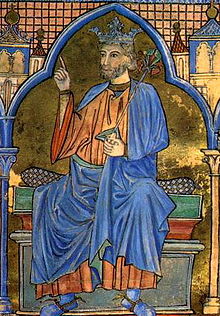
Back فرناندو الثالث (ملك قشتالة) Arabic فرناندو التالت ملك كاستييا ARZ Fernandu III de Castiella AST Фердынанд III Кастыльскі Byelorussian Фернандо III (Кастилия) Bulgarian Fernando III Kastilha Breton Ferran III de Castella Catalan Ferdinand III. Kastilský Czech Фернандо III (Кастили королӗ) CV Ferdinand III. (Kastilien) German
| Ferdinand III | |
|---|---|
 Ferdinand III in a 13th-century miniature | |
| King of Castile and Toledo | |
| Reign | 31 August 1217 – 30 May 1252 |
| Predecessor | Berengaria |
| Successor | Alfonso X |
| King of León and Galicia | |
| Reign | 24 September 1230 (de facto) or 11 December 1230 (de jure) – 30 May 1252 |
| Predecessor | Sancha and Dulce (de jure) Alfonso IX (de facto) |
| Successor | Alfonso X |
| Born | 1199/1201 Monastery of Valparaíso, Peleas de Arriba, Kingdom of León |
| Died | 30 May 1252 (aged 50–53) Seville, Crown of Castile |
| Burial | Seville Cathedral, Seville, Spain |
| Consort | |
| Issue among others... | |
| House | Castilian House of Ivrea |
| Father | Alfonso IX of León |
| Mother | Berengaria of Castile |
Ferdinand III (Spanish: Fernando; 1199/1201 – 30 May 1252), called the Saint (el Santo), was King of Castile from 1217 and King of León from 1230 as well as King of Galicia from 1231.[1] He was the son of Alfonso IX of León and Berenguela of Castile. Through his second marriage he was also Count of Aumale. Ferdinand III was one of the most successful kings of Castile, securing not only the permanent union of the crowns of Castile and León, but also masterminding the most expansive southward territorial expansion campaign yet in the Guadalquivir Valley, in which Islamic rule was in disarray in the wake of the decline of the Almohad presence in the Iberian Peninsula. He was made a saint in 1671.
By military and diplomatic efforts, Ferdinand greatly expanded the dominions of Castile by annexing the crown of Guadalquivir river valley in the south of the Iberian Peninsula, establishing the boundaries of the Castilian state for the next two centuries. New territories included important cities such as Baeza, Úbeda, Jaén, Córdoba and Seville, that were subject of Repartimiento, given a new general charter and repopulated in the following years.
Ferdinand was canonized in 1671 by Pope Clement X. Places such as the cities of San Fernando, Pampanga and San Fernando, La Union; the Diocese of Ilagan and the San Fernando de Dilao Church in Paco, Manila in the Philippines; and in the United States, in California the City of San Fernando, the San Fernando Valley, and in Texas the Cathedral of San Fernando in San Antonio were named in his honor.
- ^ Bianchini 2012, p. 1.